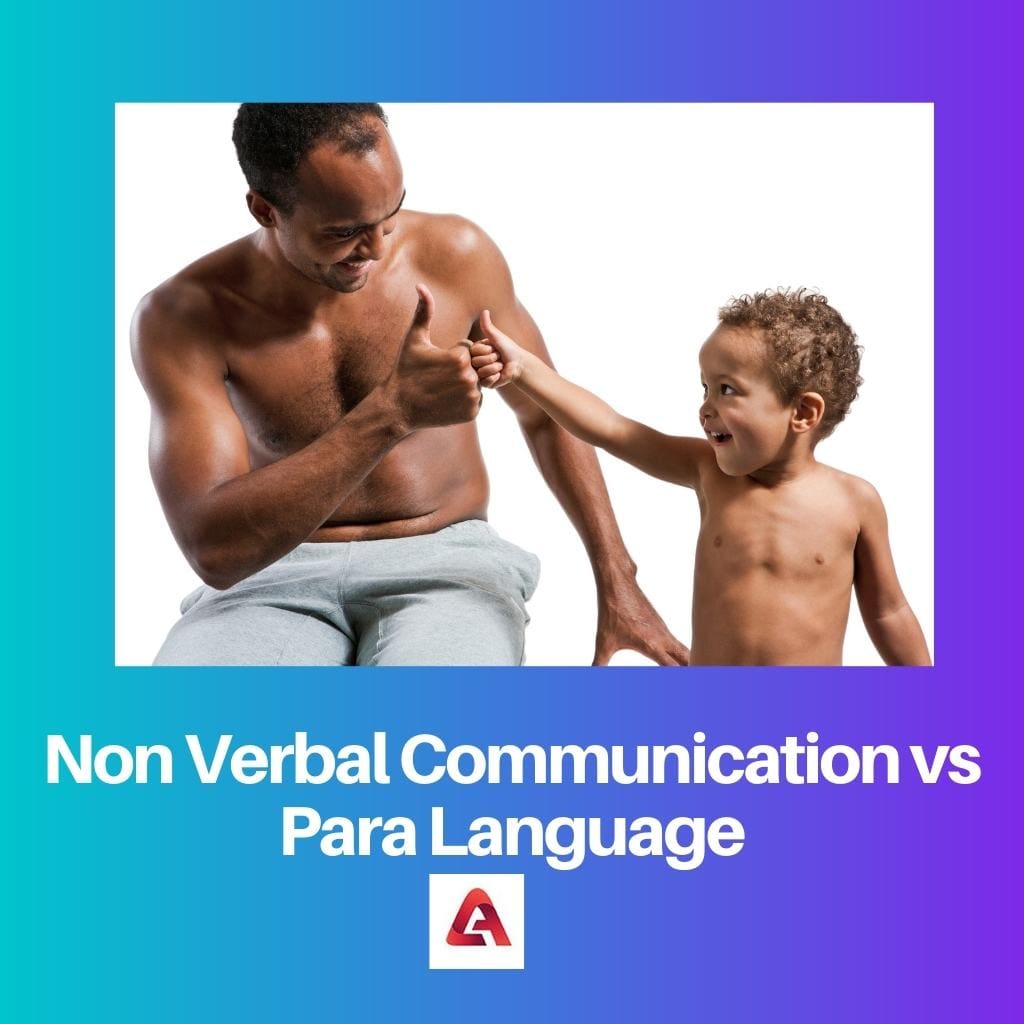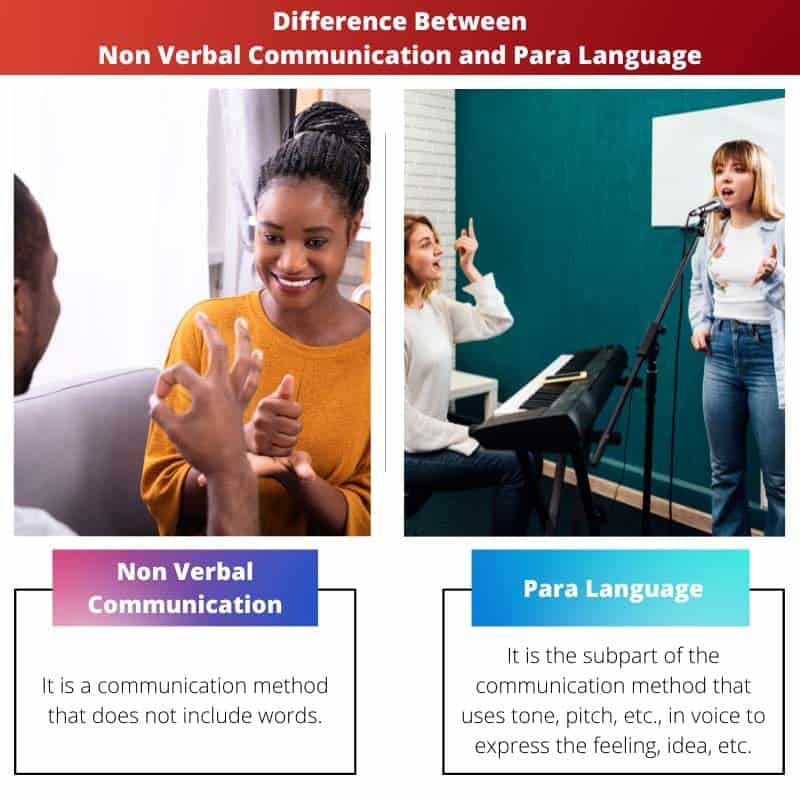A human being is a social animal who needs a medium to share his expression, ideas, and feelings. And Communication is a method by which he can share his joy, sorrow, messages, ideas, etc., with others.
There are a lot of parts of Communication, like verbal and non-verbal communication. Other subparts of these include pitch, tone, body language, paralanguage, etc.
Key Takeaways
- Non-verbal communication refers to all forms of communication other than words, while Para-language refers to non-lexical aspects of speech.
- Non-verbal communication includes facial expressions, body language, and gestures, while Para-language includes tone, pitch, and speed of speech.
- Non-verbal communication is universal and not culture-specific, while Para-language is culture-specific and varies across languages.
Non-Verbal Communication vs Para Language
The difference between Non-Verbal Communication and Para Language is that Non-Verbal Communication is a communication method in which information is exchanged without words.
On the other hand, Para Language is a subpart of Non-Verbal Communication that uses non-lexical components of speech such as tone, pitch, pauses, volume, etc.

Non-Verbal Communication is used to convey messages, ideas, or information without using words.
It can be anything, like any signal, facial expressions, gestures, etc.
Animals also use non-verbal methods to communicate with each other. It is the most important part of Communication, as verbal Communication is also incomplete without non-verbal Communication.
Para Language is part of the Non-Verbal Communication method.
It includes pitch, intonation, prosody, volume, etc., to convey the feeling or express our ideas. It can be expressed Consciously or even unconsciously.
It is a unique method in which the same message can be expressed in different forms by changing its volume, pitch, tone, etc.
Comparison Table
| Parameters of Comparison | Non Verbal Communication | Para Language |
|---|---|---|
| Definition | It is a communication method that does not include words. | The subpart of the communication method uses tone, pitch, etc., in voice to express the feeling, idea, etc. |
| Part of Body | It uses the whole body for communication. | It uses modulation of voice. |
| Method | It includes facial expressions, gestures, etc. | It includes pitch, intonation, prosody, volume, etc. |
| Requirements | It requires seeing as well as hearing a message. | It is only dependent on hearing the message. |
| Relevance | It is easy to understand as it is a compilation of many methods. | It requires other means, including itself, to understand the message. |
What is Non Verbal Communication?
Non-Verbal Communication is a communication method in which the sender and receiver exchange feelings, ideas, messages, etc., without using words.
It includes signal, posture, body language, gestures, and more things to communicate with each other.
Even animals use these methods for communicating with other animals non-verbally.
In the late 19th century, Charles Darwin writes a book on non-verbal communication methods, “The Expression of the Emotions in Man and Animals”.\
He studied how different animals, like lions, tigers, dogs, etc., communicated using expression and gestures, and by this first time, Non-Verbal Communication attracted everyone’s attention.
The study of Non-Verbal Communication is dependent on three characteristics.
The first is the environmental conditions in which Communication takes place, the second is Communicators’s physical condition, and the last is how the communicator behaves during Communication.
It can be encoded and decoded either consciously or unconsciously.
It is an essential part of the communication method, as even during Verbal Communication, we are affected mainly by body language, movements, facial tones, and other non-verbal cues.
And in any condition, when we cannot understand someone’s language of Communication, we mostly rely on non-verbal methods to communicate.

What is Para Language?
Para Language is part of Meta-Communication in which we share our message, ideas, and feelings with others using non-verbal techniques like changing voice pitch, loudness, intonation, etc.
It is a subpart of non-verbal communication; like that, it can also be expressed consciously or unconsciously.
Very little important information is shared by words whenever we speak verbally, and most of the essential things depend on Para Language.
For example, whenever someone says sorry, the word sorry means the same is dependent on the tone, pitch, the intonation of that word. So, what a person shares mainly relies on these cues, known as Para Language.
While speaking, if the speaker is taking long breaths or gasping, it shows he is nervous or telling lies.
So while communicating, these cues are more important than words; the person should be able to understand these clues.
The study of Para Language is called paralinguistics.
Many people like motivational speakers, a person giving a presentation, or a person while public speaking needs to understand the importance of Para Language as listeners also observe paralinguistic cues of the speaker. So, studying Para Language can help them to become a good speaker.

Main Differences Between Non-Verbal Communication and Para Language
- The main difference between Non-Verbal Communication and Para Language is that Non-Verbal Communication is a Communication method.
- On the other hand, Para Language is a component of the non-verbal method.
- Non-Verbal Communication is a compilation of body language, movements, postures, etc., whereas Para Language includes voice tone, pitch, prosody, etc.
- Non-Verbal Communication is a communication method that does not include words, but Para Language is a subpart of the communication method that only uses voice modulation.
- It is easy to understand Non-Verbal Communication as it is a compilation of different components. In contrast, Para Language is just one component of Communication that can not be understood alone.
- In Non-Verbal Communication receiver needs to see and listen to the message, but in Para Language, the receiver needs to listen to the cues.






